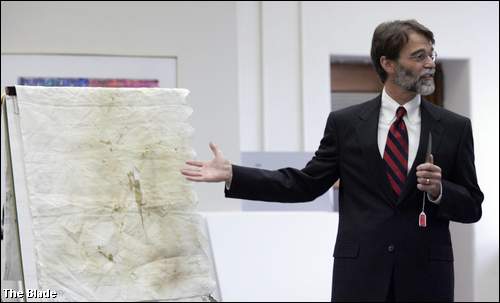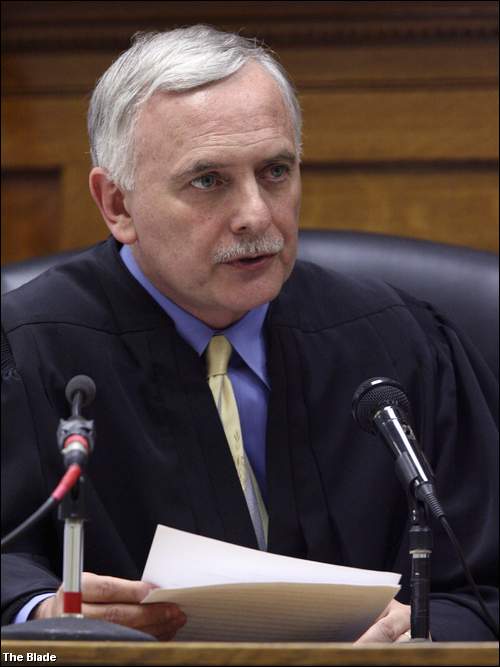Closing Arguments Completed in Nun's Slaying Case
By David Yonke
Toledo Blade
May 11, 2006
http://toledoblade.com/apps/pbcs.dll/article?AID=/20060511/NEWS02/605110391/-1/NEWS
Jurors deliberated about four hours yesterday before calling it a night and will return this morning to the Lucas County Courthouse to resume reviewing dozens of items of evidence and discussing testimonies in the Rev. Gerald Robinson's murder trial.
 |
|
Assistant prosecutor Dean Mandros said anger was the motive for the slaying. Defense attorney John Thebes said the experts' testimony wasn't good enough. Photo by The Blade/Andy Morrison |
Attorneys wrapped up their cases with nearly four hours of closing arguments yesterday in what is believed to be the first U.S. trial of a U.S. Roman Catholic priest charged with murdering a Roman Catholic nun.
Before the closing arguments, the prosecution called two rebuttal witnesses to dispute contentions that tests conducted on the victim's exhumed body may have compromised evidence.
For the first time in the trial, which began April 21 in Judge Thomas Osowik's court, the prosecution yesterday suggested that Father Robinson, now 68, choked and stabbed Sister Margaret Ann Pahl to death on April 5, 1980 - Holy Saturday - in the sacristy of Mercy Hospital because he was angry at her and mad at God.
 |
|
Defense attorney John Thebes said the experts' testimony wasn't good enough. Photo by The Blade/Andy Morrison |
The defense hammered at what it considers to be holes and flaws in the prosecution's case, contending that a pair of scissors missing from the chapel could have been used to stab the nun instead of the state's assertion that the 31 stab wounds were made by the priest's saber-shaped letter opener.
Defense attorney John Thebes, who spoke for 45 minutes, said ribbed bloodstains found on an altar cloth at the murder scene could have been made by the fabric in Sister Margaret Ann's dress and were not necessarily from the ribbed handle of the letter opener.
He challenged conclusions of forensic experts who said they "could not exclude" the letter opener from being the murder weapon, or that the weapon used to stab the nun was "similar to" "or consistent with" the priest's letter opener.
"That just isn't good enough," Mr. Thebes said. "Not one expert came in and said, 'This is the murder weapon.'"
 |
|
Judge Thomas Osowik defined 'reasonable doubt' for the jury before it began its deliberations yesterday. Photo by The Blade/Andy Morrison |
Dean Mandros, a Lucas County assistant prosecutor, told jurors in his hour-long closing argument that although the state is not required to prove a motive, "I'm going to suggest to you why this crime occurred."
Despite testimony by a priest that Sister Margaret Ann's murder included a number of anti-Christian symbols and rituals, her death was not "a satanic cult-killing" or "part of some ritualistic black mass," Mr. Mandros said.
"This case is about perhaps the most common scenario there is for a homicide: A man got very angry at a woman and the woman died. The only thing different is the man wore a white collar and the woman wore a habit," Mr. Mandros said.
He described Father Robinson as a person who was angry at the world, mad at the church, and at odds with Sister Margaret Ann, whom the priest described to police as a "dominant" woman.
Mr. Mandros said Father Robinson was tired of working as a hospital chaplain and having to perform Last Rites and deal with grieving relatives of dying patients every day.
The assistant prosecutor cited a nun's testimony that the priest told her he wanted to be a military chaplain.
Mr. Mandros said Sister Margaret Ann had been upset over the way Father Robinson conducted the Good Friday services, and "less than 18 hours later, she was found butchered on the sacristy floor. He had had enough. He had taken a lot, but he wasn't going to take any more," Mr. Mandros said.
He said the priest intended not just to murder the victim, but also to humiliate and mock her. That's why he killed her in front of the Holy Eucharist in the sacristy and why he stabbed her with a sword-shaped letter opener, over the heart, nine times in the shape of an inverted cross.
Mr. Mandros said Father Robinson stabbed Sister Margaret Ann 22 more times because he wanted to get enough blood to soak his weapon and then "anoint" her forehead with it.
In a final act of degradation and humiliation, he said, the priest pulled the nun's dress up to her chest and her girdle down over her feet, then "penetrated" her with either the letter opener, a cross, or a finger, based on a 1980 autopsy report.
Mr. Mandros also pointed out that three witnesses testified they saw Father Robinson near the hospital chapel, adjacent to the sacristy, shortly before and after police and coroners believe the murder took place.
Father Robinson told police in 1980 and again when he was arrested April 23, 2004, that he had been in his residence at the hospital the entire morning until getting a phone call that Sister Margaret Ann had been killed.
"Now those three people are very, very important witnesses because if you believe what they say, then you can't believe his story," Mr. Mandros said, pointing at Father Robinson. "If you believe what they say, you know who went into that chapel. You know who killed Sister Margaret Ann Pahl."
He also cited Father Robinson's admission in 1980 that he lied during a police interrogation. The priest told police that another person confessed to him about killing the nun. But when pressed by the officers, Father Robinson said he made that up to protect himself.
Alan Konop, another of Father Robinson's four defense attorneys, ran through a list of witnesses - 30 for the prosecution, 10 for the defense - to highlight what he called "important inconsistencies and discrepancies" in the state's case and a "lousy investigation" by police in 1980.
He said that when the prosecution called the Rev. Jeffrey Grob, a Catholic priest from Chicago and an expert in rituals as a witness, the priest called Sister Margaret Ann's death a ritualistic killing that was designed to mock her, mock the church, and mock God.
Mr. Konop told jurors that Mr. Mandros backed down from asserting it was a ritual killing because Father Grob's testimony "didn't turn out the way he thought it would turn out."
He contended that the Lucas County cold-case squad was not seeking justice when it reopened the murder case in December, 2003, but was looking only to arrest Father Robinson.
Chris Anderson, assistant Lucas County prosecutor, gave the final closing argument, methodically reviewing most of the points the defense said raise reasonable doubts.
He showed illustrations of stab wounds in Sister Margaret Ann's body and quoted expert testimony that the four-sided punctures could not have been made by scissors because the wounds were made by an instrument, unlike scissors, whose sides were all sharp.
Regarding DNA found on the nun's underwear and on fingernails that showed a male chromosome that could not have been Father Robinson's, it was "not relevant evidence" because DNA was not used by crime labs in 1980, Mr. Anderson said. No precautions were taken then to prevent contamination and the small amount of DNA found - 30 trillionths of a gram - could have been deposited on the nun's body through casual contact with a man such as a doctor who rushed to her aid, Mr. Anderson said.
Prior to closing arguments, Dr. Diane Barnett, a Lucas County deputy coroner, and Julie Saul, director of forensic anthropology for the Lucas County coroner's office, were interviewed over "fit tests" they conducted on Sister Margaret Ann's jawbone to see if the letter opener fit a wound.
Kathleen Reichs, a forensic anthropologist from North Carolina, testified for the defense on Monday that it was improper to insert a metal blade into the nun's bones because it could potentially contaminate the evidence.
Dr. Barnett and Ms. Saul asserted that their tests proved the letter opener was a "perfect fit" and that no damage was done to the bone, which is one of the hardest in the human body. They said any damage to the bone would have been clearly evident because a fracture would have revealed lighter-colored section beneath the brown exterior.
The jury of 12 - seven women and five men - is scheduled to resume deliberating at 9 a.m. today. No time frame was set by Judge Osowik for them to reach a verdict except that they will not stay past 8 p.m.
In his instructions to the jury, the judge explained that circumstantial and direct evidence are equal in the eyes of the law.
He also said "reasonable doubt is present when, after you have carefully considered and compared all the evidence, you cannot say you are firmly convinced of the truth of the charge. Reasonable doubt is a doubt based on reason and common sense. Reasonable doubt is not mere possible doubt because everything relating to human affairs or depending on moral evidence is open to some possible or imaginary doubt."
Thirty minutes after beginning deliberations, the jury requested and was given a list of all witnesses who testified during the trial.
If convicted, Father Robinson faces a mandatory sentence of life in prison.
Contact David Yonke at:
dyonke@theblade.com
or 419-724-6154.
Recent Related Articles
• Jury Begins Deliberations in Priest's Murder Trial
• Priest's Case Likely to End up in Jury's Hands Today
• Anchors Downplay Criticisms of Defense
• Defense Rests in Father Robinson Murder Trial
• Police Grilled on Holes in Probe of Nun's Killing
• Defense Probes Police Testimony for Inconsistencies
• Priest's Murder Trial Delayed for Second Day
• Nun's Killer Used Occult Symbols, Church Expert in Rituals Testifies
• Catholic Expert on Rituals Set to Testify
• Cold-Case Detective Tells Why Priest Was Suspect
• Priest's Decision to Shorten Mass Upset Slain Nun, Woman Testifies
• Victim's Nephew Watches Testimony 'Hoping for Justice'
• Forensic Expert Says Letter Opener Could Have Been Used to Stab Nun
• Experts Testify on Bloodstain Patterns, DNA
• Weapon Linked to Nun's Death; Coroner Says Letter Opener Fit Jaw Wound
Any original material on these pages is copyright © BishopAccountability.org 2004. Reproduce freely with attribution.